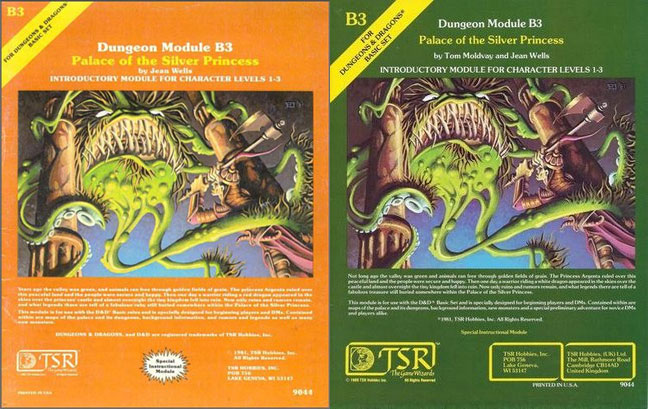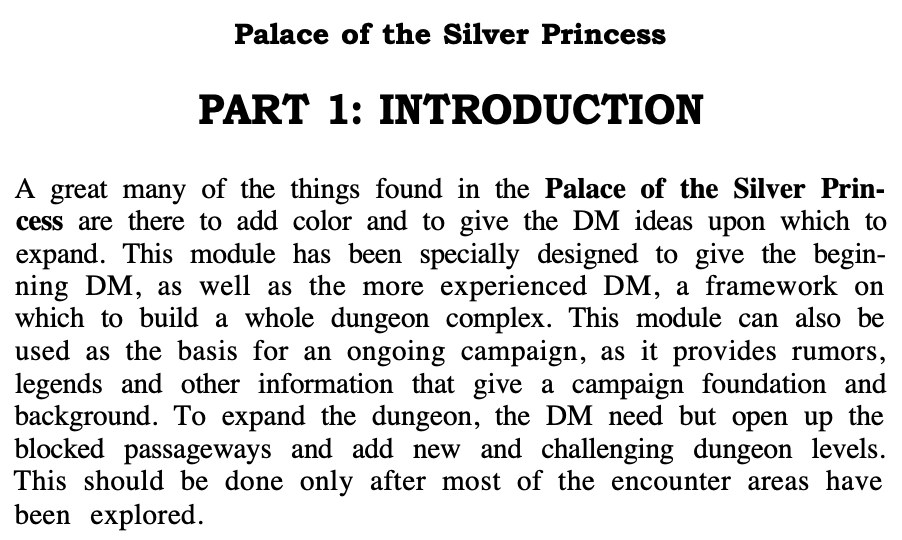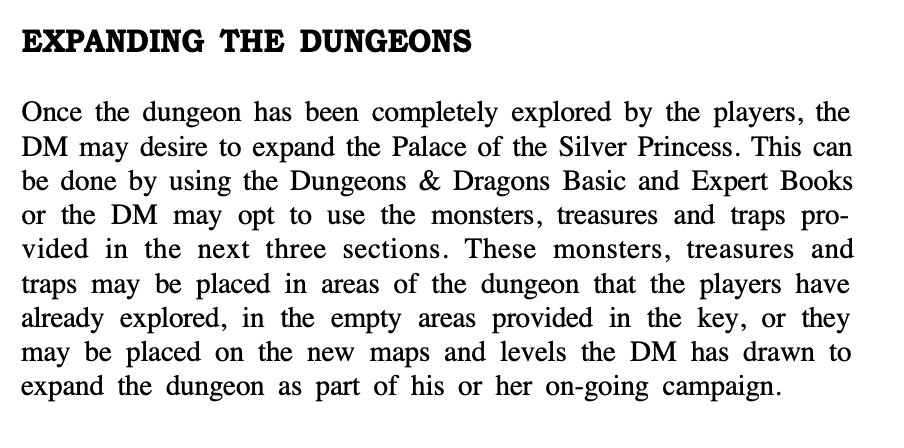Palace of the Silver Princess: Part 1

I recently organized a new gaming group, composed mostly of some coworkers who have never played a TTRPG, but who have all been curious. Since there are so many new players, I decided to tap into my recently acquired collection of early D&D modules. I just finished B2 - Keep on the Borderlands for one group, and I’m going to run B4 for another. I thought why not run B3 - Palace of the Silver Princess, by Tom Moldvay and Jean Wells.
This series of articles details my process for preparing this classic module. In Part 1, I discuss a little about the interesting history of this module, my initial reaction to both versions, and my initial plans.
Reading the Published B3 Module
I don’t know about you, but a first reading through a module is a really fun time for me. In a way, I’m running through the module for the first time myself, and experiencing the adventure and surprises the players do, just from a different angle. I opened the green covered B3 module by Tom Moldvay and Jean Wells, and excitedly began to read.
The premise was interesting at first. The land of Haven, once an idyllic land of beauty and plenty, has recently experienced a disaster. Dwarves unearthed a large ruby which they called “My Lady’s Heart”, and gifted it to the beloved Princess Argenta, the princess whom the module is named after. Little did they know that the ruby was one of the Eyes of Arik, a demonic being trapped in another dimension, sometimes worshipped as a god. During a party meant to honor the dwarves’ gift, Princess Argenta was visited by a mysterious man and his dragon. The Princess disappeared, a dragon scorched the lands of Haven and very quickly the land was overrun by evil and death.
It is the player’s job to find and destroy the ruby, rescue the princess and restore the land of Haven to its former glory.
Now, anyone who runs classic adventures can expect to run into some RPG tropes, but something about this just wasn’t working for me. It’s just way too Lord of the Rings for my taste, which wasn’t a trope I was interested in.
I was also surpised to find that the module is a bit of a railroad. The players are dropped off at the Palace, which is surrounded by a deadly red glow, and the only way in is for faerie-like “Protectors” to let them in. At this point, the player’s can’t get out and must finish the adventure. There are a number of tasks that must be completed, and a few options for destroying the ruby, but otherwise the players will go through the palace, confront the BBEG and destroy the ruby. To make sure the players stay on track, the module suggests giving the players visits or “visions” from the Protectors, if they start getting any ideas that deviate from the planned adventure.
I don’t like running railroads, and prefer more sandbox-ish adventures, so I already knew some rewriting was in order. I was already thinking about creating a region map with a town or village as home base, something akin to Keep on the Borderlands, when inspiration came from an unexpected source.
The Jean Wells Original
For those who don’t know, the green covered version of Palace of the Silver Princess by Tom Moldvay and Jean Wells is not the original. An earlier version, written exclusively by Jean Wells, had been recalled, pulled from shelves, and destroyed on the eve of publication. The reasons for this are somewhat conflicting, even according to TSR employees themselves, though it would seem that it was due to multiple factors:
- Some scandalous artwork such as a multi-headed monster whose appearance looked a little too much like TSR execs
- The artwork for the Illusion of the Decapus, showing a woman tied up with her own hair being tortured. This was during the Satanic Panic, and TSR may have wanted to avoid the negative perception, especially as B3 was for the Basic edition, which ostensibly targeted a younger audience.
- The module is poorly organized
- The module is intended to be a teaching module for DMs, but leaves a bit too much work for the DM, making it a rather incomplete module.
For more on this, I would recommend reading the following:
Regardless of the exact reason, the original B3 was lost, other than a handful of shrink-wrapped copies selling for large amounts. That is, until WotC finally released a PDF of the original in the early 2000’s. This PDF is now easily found in many places online, including here, at the Vaults of Pandius.
And so it was that I found myself seeking inspiration from the Jean Wells original. I wasn’t expecting to find much, but anything that I could use to improve the published version would be great, right?
However, I was surprised at what I found.
A Treasure Trove of Ideas
There was much more here than I expected in the original module.
- A region map with a small gazetteer and several towns/villages, each described briefly
- A baroness who, despite being ruthless, is the true heir of the Silver Princess
- A haunted/cursed woods
- A swamp with a wizard tower rumored to be in the center, and where magic does not function as expected
- A mountain range where storms brew and a witch living in a tree is rumored to live
- A tinker NPC who travels the region with his daughter, both of whom seem to be more than meets the eye.
- Aliegha, a were-bear NPC who wields the magic Sword of Spartusia
- Cathrandamus, the BBEG who also happens to be a wandering cleric who heals people for money
This is an absolute gold mine! There are so many different adventure hooks and potential conflicts here, so many interesting places to explore, hidden secrets, legends, rumors and fun. Now, I realize that as modules go, this could have been a lot more complete, with random encounter tables for the region, more NPCs including the wizard, the wizardress, Lady D’Mhis, a more fleshed out home base, etc. But I think the point of this module was to give Dungeon Masters some building material; a jumping off point for creating their own larger adventure. In a way, it succeeds at this. Any DM who enjoys employing their creativity to flesh out an adventure has a lot to work with here.

The dungeon itself is pretty interesting, though not amazing and does have an infamous error, but again, I think it’s a great starting point for DMs wanting to do more of the work on building the adventure and making it their own. The rooms aren’t fully keyed as they are in the Green version either, which is ok by me.

Thankfully, I’m not the only one who has the opinion of just how much better Jean Well’s version is. Check out this awesome take over at Cave of the Dice Chucker.
A New Plan Emerges
I now know what I’m going to do for this adventure. I’m going to run the Jean Wells original adventure, and do it exactly the way Jean Wells suggests: I’m going to make it my own. I want to stay as true to the original as I can, retain some of the more memorable elements from the Moldvay rewrite, and a lot of my own ideas and adjustments. My plan is to expand it into the engaging sandbox adventure that it has the potential to be.
Check back to see the next step.